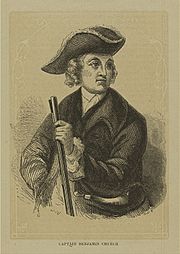Raid on Chignecto (1696) facts for kids
Quick facts for kids Raid on Chignecto (1696) |
|||||||
|---|---|---|---|---|---|---|---|
| Part of King William's War | |||||||
 Colonel Benjamin Church: Father of American ranging |
|||||||
|
|||||||
| Belligerents | |||||||
| Mi'kmaq militia Acadian militia |
|||||||
| Commanders and leaders | |||||||
| Father Claude Trouve | Benjamin Church, John Gorham | ||||||
| Strength | |||||||
| unknown Mi’kmaq and village residents | 400 New England troops and native warriors, | ||||||
| Casualties and losses | |||||||
| unknown | unknown | ||||||
The Raid on Chignecto was an attack that happened during a big conflict called King William's War. In September 1696, soldiers from New England (near Boston) attacked a place called Isthmus of Chignecto in Acadia. Today, this area is part of Nova Scotia, Canada.
This attack was a way for New England to get back at the French and their Native American allies. Earlier that year, the French and Native Americans had won the Siege of Pemaquid (1696) in what is now Bristol, Maine. Colonel Benjamin Church led the New England force, which had about 400 men. The raid lasted for nine days, from September 20 to September 29, 1696. It was part of a bigger plan by Church to attack several other Acadian communities.
Why the Raid Happened
During King William's War, which was the first of four major conflicts between the French and English in North America, the French and Native Americans had a big win. They successfully attacked and destroyed Fort William Henry at Pemaquid. Colonel Benjamin Church had actually helped build that fort.
After their victory, the Acadians in Chignecto put up a sign on their church door. This sign proudly announced the French success at Pemaquid. To get revenge for the loss of Fort William Henry, Colonel Church led a strong attack on the Isthmus of Chignecto at a place called Beaubassin in 1696.
The Attack on Beaubassin
On September 20, Church and his 400 men arrived near Beaubassin. About 50 to 150 of his soldiers were Native Americans, likely from the Iroquois tribes. As they came ashore, the Acadians and Mi'kmaq people started shooting at them. Church's group lost one officer and several other men.
However, they managed to get onto land and surprise the Acadians. Many of the villagers ran away. One person tried to stop Church by showing him papers. These papers said that the Acadians had promised to be loyal to the English king back in 1690.
Church did not believe them, especially after he found the sign on the church door celebrating the French victory at Pemaquid. He then ordered his men to burn many buildings, kill some of the people, and steal their belongings. They also killed the villagers' farm animals. The French governor, Villebon, later wrote that the English stayed in Beaubassin for nine days. He said they took everything from the settlers, leaving them with empty homes and only the clothes they were wearing.
What Happened Next
After the raid, on September 29, Church and his men moved towards the mouth of the Saint John River. There, Church captured two Frenchmen. From them, he learned about some cannons buried nearby. He dug up these cannons and then headed back towards Boston.
Later, at a place called Passamaquoddy, Church's group met Colonel John Hathorn. Hathorn took charge of all the soldiers. They then went up the Saint John River to attack the capital of Acadia, Fort St. Joseph (also known as Nashwaak). Today, this area is Fredericton, New Brunswick. However, this attack on the fort was not successful.
Before leaving Chignecto, Church warned the Acadians. He told them he would come back if any more New Englanders were harmed. He did return to raid Chignecto again later during Queen Anne's War. That campaign also included another attack called the Raid on Grand Pré.

